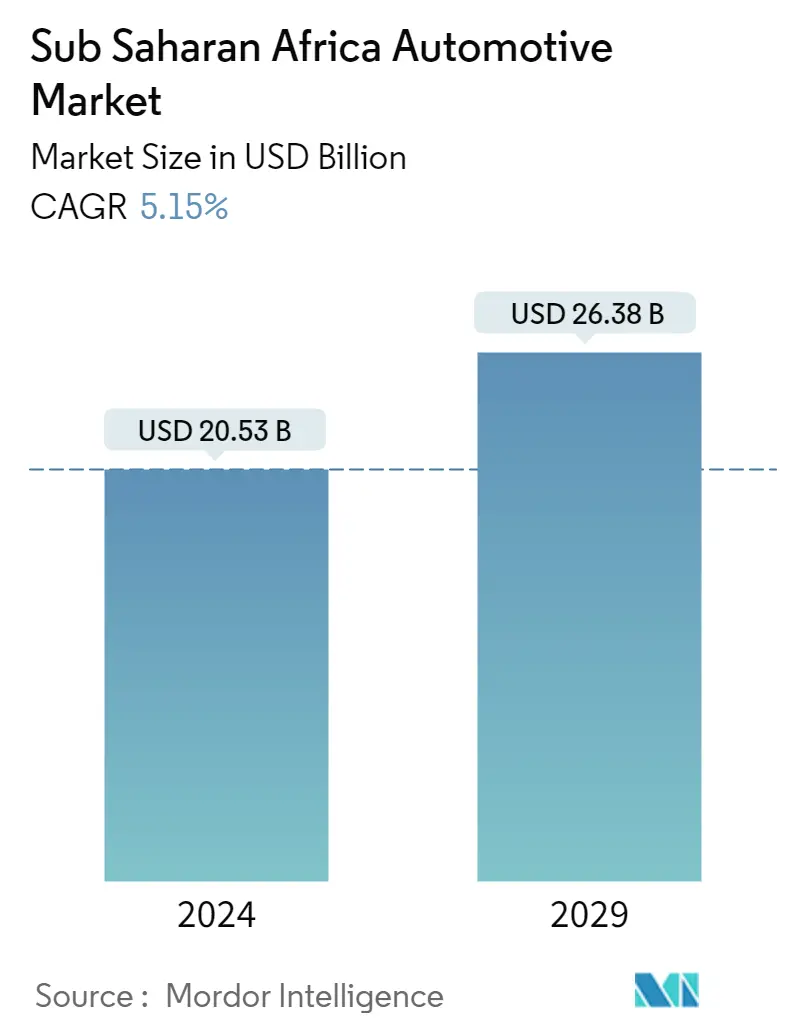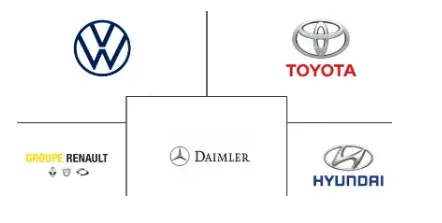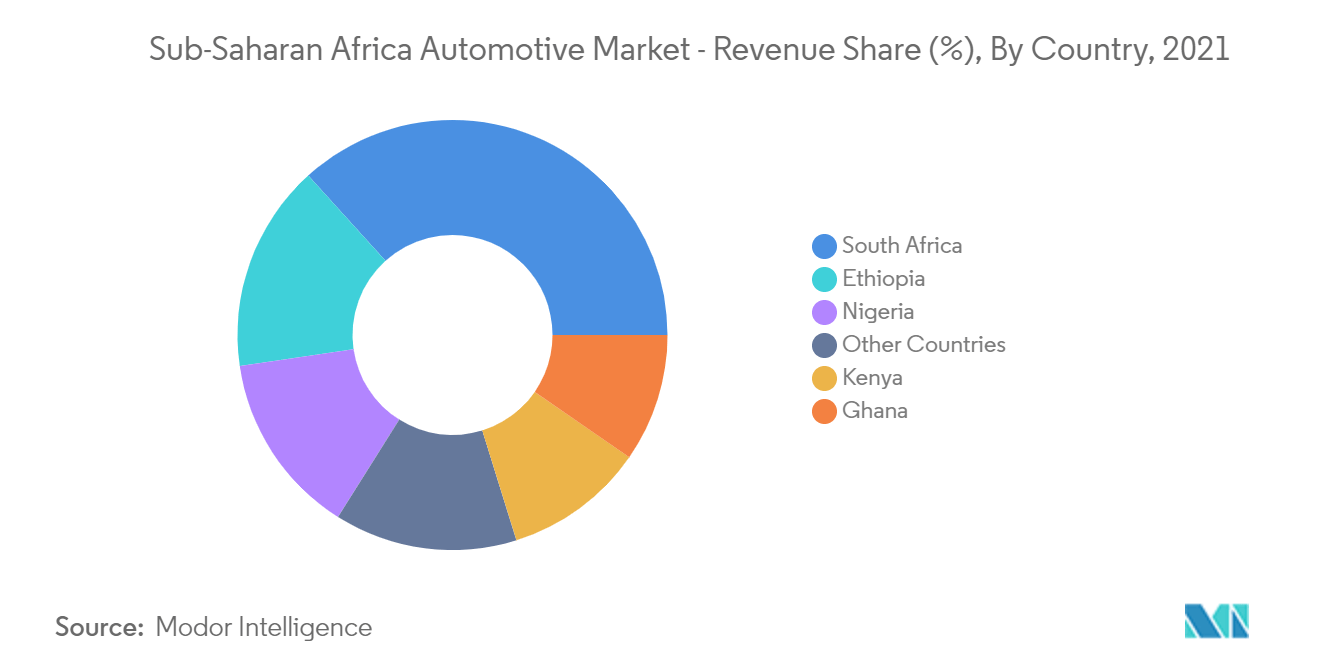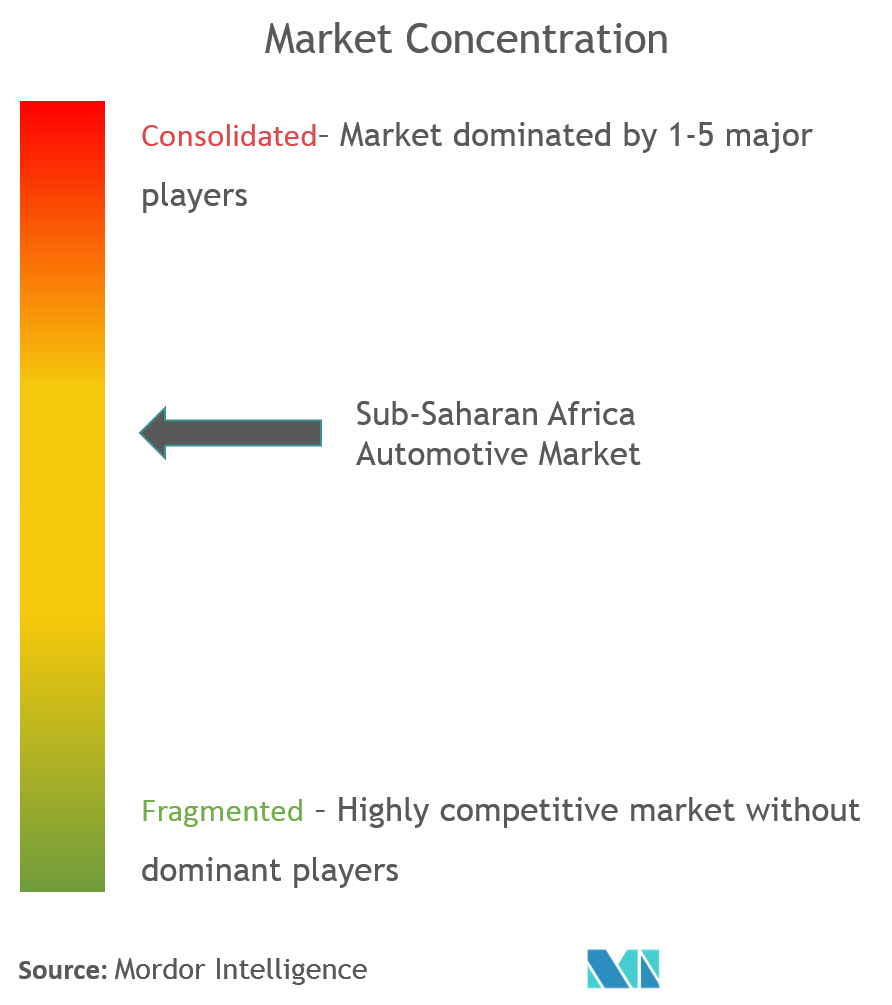Africa Automotive Market Size

| Study Period | 2019 - 2029 |
| Base Year For Estimation | 2023 |
| Market Size (2024) | USD 20.53 Billion |
| Market Size (2029) | USD 26.38 Billion |
| CAGR (2024 - 2029) | 5.15 % |
| Market Concentration | Medium |
Major Players
*Disclaimer: Major Players sorted in no particular order |
Africa Automotive Market Analysis
The Sub Saharan Africa Automotive Market size is estimated at USD 20.53 billion in 2024, and is expected to reach USD 26.38 billion by 2029, growing at a CAGR of 5.15% during the forecast period (2024-2029).
The COVID-19 pandemic had a significant impact on the market, and demand is still lagging behind pre-COVID levels. Until 2018, the demand for new vehicles in the African region increased. However, governments across the region are taking initiatives to boost the automotive industry by implementing a ban on imported used vehicles. According to the data from the National Automotive Design and Development Council (NADDC), Nigeria spends about NGN 2.88 trillion (USD 8 billion) on the importation of about 300,000 to 400,000 cars, yearly.
Over the medium term, some governments in Sub-Saharan Africa have begun to announce vehicle electrification targets and incentives for EV adoption, such as Rwanda's tax exemptions for EV sales. Furthermore, a burgeoning start-up ecosystem for EVs, with a focus on electric two-wheelers, is emerging in the region. According to automotive experts, there were more than 20 start-ups in the ecosystem at the end of 2021, with total funding of more than $25 million that year.
Additionally, to discourage the importation of vehicles and encourage local vehicle production, Nigeria slammed 70% import duty and levied on imported vehicles. This resulted in increased volume of locally assembled and manufactured vehicles in the country and most of the local companies have seen developments in their manufacturing process and capacity. For instance,
- Innoson Vehicles Manufacturing Limited (IVM) opened a new automated plant for manufacturing bus at Nnewi, Anambra State, in 2019. The automated plant reduced the cost of new 15-17-seater Hummer bus from NGN 16 million to NGN 9 million.
However, Due to low disposable income and very high cost associated with new vehicles, used vehicles dominate some of sub-saharan countries automotive retail sector. These vehicles are mainly imported from regions with low resale or residual values of used vehicles like Europe, Japan, and the United States. This might hamper the target market during the forecasted timeperiod.
Africa Automotive Market Trends
This section covers the major market trends shaping the Sub Saharan Africa Automotive Market according to our research experts:
Rising Other Alternative Fuel to Drive Demand in the Market
Transport currently accounts for 10% of Africa's total greenhouse gas (GHG) emissions, and this figure is expected to rise as Sub-Saharan Africa's vehicle park expands. The vehicle parc is expected to grow from 25 million vehicles today to an estimated 58 million by 2040 in the six countries that account for roughly 70% of Sub-Saharan Africa's annual vehicle sales and 45 percent of the region's population (South Africa, Ethiopia, Rwanda, Uganda, Kenya, and Nigeria), driven by urbanization and rising incomes. As its vehicle park expands, Sub-Saharan Africa's challenge will be to push for more sustainable mobility while avoiding becoming a dumping ground for the world's unwanted used ICE vehicles.
While momentum is building, Sub-Saharan Africa faces some unique challenges in its electric mobility transition, including unreliable electricity supply in some cases, low vehicle affordability, and reliance on used vehicles. Many countries have made significant progress toward improving electricity access (all six countries mentioned have urban electricity access rates above 70%, with some exceeding 90%); however, electricity reliability remains a concern. Furthermore, the 2020 System Average Interruption Disruption Index (SAIDI) for Sub-Saharan Africa was reported to be 39.30, compared to 0.87 for OECD high-income countries.
Africa's infrastructure is also improving, which will help the region's automotive market. Some countries are expected to drive growth until 2023, with countries such as Ghana playing key roles.
- Ghana aspires to be a developed nation by 2030. If the country meets even half of its target, the Ghanaian automotive market is expected to expand at a rapid pace, as economic growth is directly proportional to the growth of automotive markets.
Various companies are also either launching or planing to launch their electric vehicle in the region to witness a considerable market share in the upcoming years. For instance,
- The recently launched Eleksa CityBug is the most affordable EV to hit South African roads. The new Eleksa costs R230 000 at the point of sale. In the country, the CityBug is still proving its roadworthiness.

South Africa is Expected to be the Continent's Largest Automotive Industry
The vehicle interest rates have been fluctuating across the Sub-Saharan African countries annually and it is highly dependent on the economic growth of the individual country. The South African automotive industry is still adapting to market forces. The increasing number of imported vehicles and the aftereffects of the global economic crisis, particularly the uncertainty regarding European markets and the impact on local exports, are affecting manufacturing.
These forces have also required the automotive aftermarket to respond. Both areas are further impacted by rising electricity and raw material prices, as well as rising labor rates, low productivity, and a lack of flexibility. Automotive companies must continuously develop and maintain customer relationships, achieve technical excellence and retain skilled labor pools, and manage significant risks in order to survive and grow.
Auto sales in South Africa in 2022. Toyota sold 7,086 units (18.4% share) of passenger vehicle sales in June, VW sold 5,652 units (14.7% share), and Suzuki sold 4,622 units (12.0% share). Daimler Trucks and Buses sold 387 units (14.9%), Toyota 353 units (13.6%), and Isuzu 322 units (12.4%) of commercial vehicle sales in June.

Africa Automotive Industry Overview
The automotive industry in the region is dominated by leading manufacturers such as Volkswagen, Toyota, Nissan, Hyundai, and Suzuki. A few of the recent developments include:
- In July 2022, the South African variant of Creta's cosmetic upgrades is shared with the new iteration sold in Indonesia. This includes the new generation Tucson's 'Parametric Jewel' design theme for the grille and split LED headlights. The Interior remains largely unchanged, with the addition of an 8-inch touchscreen. It comes with up to six airbags, electronic stability control (ESC), and ABS with EBD.
- In August 2022, Maruti Suzuki also launched its new compact SUV Grand Vitara in foreign markets. The Grand Vitara SUV was recently showcased in South Africa by India's largest carmaker ahead of its official launch. Grand Vitara, which will take the place of the S-shaped cross.
- In the MoU signed in Nigeria, Volkswagen has committed itself to expanding manufacturing/production operations on a step-by-step basis and to turning Nigeria into an automotive hub on the western coast of Africa, over the long term.
Africa Automotive Market Leaders
-
Nissan Motor Co., Ltd.
-
Toyota South Africa Motors (Pty) Ltd
-
Volkswagen South Africa
-
Hyundai Automotive South Africa
-
Suzuki Auto South Africa
*Disclaimer: Major Players sorted in no particular order

Africa Automotive Market News
- In May 2022, The 2022 Toyota Starlet arrived in South Africa, with a starting price of SAR 226,200. The premium hatchback, known as the Toyota Glanza in the U.S., is manufactured in India and exported under the Starlet brand. It was recently relaunched in India with significant changes.
Africa Automotive Market Report - Table of Contents
1. INTRODUCTION
1.1 Study Assumptions
1.2 Scope of the Study
2. RESEARCH METHODOLOGY
3. EXECUTIVE SUMMARY
4. MARKET DYNAMICS
4.1 Market Drivers
4.2 Market Restraints
4.3 Industry Attractiveness - Porter's Five Force Analysis
4.3.1 Threat of New Entrants
4.3.2 Bargaining Power of Buyers/Consumers
4.3.3 Bargaining Power of Suppliers
4.3.4 Threat of Substitute Products
4.3.5 Intensity of Competitive Rivalry
5. MARKET SEGMENTATION
5.1 Body Style Type
5.1.1 Hatchback
5.1.2 Sedan
5.1.3 Sports Utility Vehicles
5.1.4 Others (Mini-vans, MPV, etc.)
5.2 By Vehicle Type
5.2.1 Passenger Cars
5.2.2 Commercial Vehicles
5.3 By Fuel Type
5.3.1 Gasoline
5.3.2 Diesel
5.3.3 Other Alternative Fuels
5.4 Country
5.4.1 South Africa
5.4.2 Nigeria
5.4.3 Kenya
5.4.4 Ethiopia
5.4.5 Ghana
5.4.6 Other Countries (Tanzania, Angola, Zambia, etc. )
6. COMPETITIVE LANDSCAPE
6.1 Vendor Market Share
6.2 Company Profiles*
6.2.1 Toyota Motor Corporation
6.2.2 Volkswagen AG
6.2.3 Hyundai Motor Company
6.2.4 Groupe Renault
6.2.5 Nissan Motor Co., Ltd.
6.2.6 Isuzu Motors Ltd
6.2.7 Ford Motor Company
6.2.8 Honda Motor Company, Ltd.
6.2.9 Subaru Corporation
6.2.10 Suzuki Motor Corporation
7. MARKET OPPORTUNITIES AND FUTURE TRENDS
Africa Automotive Industry Segmentation
The Sub-Saharan automotive market outlook examines the region's growing demand for passenger cars, commercial vehicles, and two-wheelers, OEM investments to establish a presence in countries, developments in the electric vehicle market, and market shares of both OEMs and OES. Regulations on importing new and used vehicles, taxes levied by the government for new & used vehicles, government initiatives to boost the automotive industry, and the future of the Sub-Saharan Africa Automotive industry.
The Sub-Saharan Africa Automotive market is segmented by Body Style Type, Fuel Type, Vehicle Type, and Geography.
By Body Style Type, the market is segmented into Hatchback, Sedan, Sport Utility Vehicles, and Others. BY Fuel Type, the market is segmented into Gasoline, Diesel, and Other Alternative Fuels. By Vehicle Type, the market is segmented into Passenger Cars, Commercial Vehicles, and Two-wheelers. By Geography, the market is segmented into South Africa, Kenya, Nigeria, Ethiopia, Ghana, and Other Countries. For each segment, the market size, and forecast have been done on basis of value (USD million).
| Body Style Type | |
| Hatchback | |
| Sedan | |
| Sports Utility Vehicles | |
| Others (Mini-vans, MPV, etc.) |
| By Vehicle Type | |
| Passenger Cars | |
| Commercial Vehicles |
| By Fuel Type | |
| Gasoline | |
| Diesel | |
| Other Alternative Fuels |
| Country | |
| South Africa | |
| Nigeria | |
| Kenya | |
| Ethiopia | |
| Ghana | |
| Other Countries (Tanzania, Angola, Zambia, etc. ) |
Africa Automotive Market Research FAQs
How big is the Sub Saharan Africa Automotive Market?
The Sub Saharan Africa Automotive Market size is expected to reach USD 20.53 billion in 2024 and grow at a CAGR of 5.15% to reach USD 26.38 billion by 2029.
What is the current Sub Saharan Africa Automotive Market size?
In 2024, the Sub Saharan Africa Automotive Market size is expected to reach USD 20.53 billion.
Who are the key players in Sub Saharan Africa Automotive Market?
Nissan Motor Co., Ltd., Toyota South Africa Motors (Pty) Ltd, Volkswagen South Africa, Hyundai Automotive South Africa and Suzuki Auto South Africa are the major companies operating in the Sub Saharan Africa Automotive Market.
What years does this Sub Saharan Africa Automotive Market cover, and what was the market size in 2023?
In 2023, the Sub Saharan Africa Automotive Market size was estimated at USD 19.52 billion. The report covers the Sub Saharan Africa Automotive Market historical market size for years: 2019, 2020, 2021, 2022 and 2023. The report also forecasts the Sub Saharan Africa Automotive Market size for years: 2024, 2025, 2026, 2027, 2028 and 2029.
How is technology influencing the Automotive Market in Sub-Saharan Africa?
Technological advancements are shaping the Automotive Industry in the Sub-Saharan Africa market through the introduction of more fuel-efficient and environmentally friendly vehicles, as well as improvements in manufacturing processes.
Africa Automotive Industry Report
The Sub-Saharan Africa automotive market is dynamic and evolving, driven by increasing population, rising disposable income, and improving infrastructure. This market includes passenger vehicles, commercial vehicles, and two-wheelers, each catering to different consumer needs. Urban areas see strong demand for passenger vehicles due to rising income levels and better road infrastructure, while commercial vehicles are vital for economic activities and logistics. Two-wheelers are popular in rural regions for their affordability and convenience. Despite challenges like inadequate infrastructure and high import duties, the market offers significant growth and investment opportunities. Governments are boosting local manufacturing to reduce import reliance, driving further market expansion. The competitive landscape features international manufacturers and local assemblers vying for market share through product differentiation, pricing strategies, and after-sales services. As the market grows, industry participants must adapt to changing consumer preferences and leverage strategic partnerships. For detailed statistics on the African motor company market share, size, and revenue growth rate, refer to the Africa Automotive analysis by Mordor Intelligence™ Industry Reports. Get a sample of this industry analysis as a free report PDF download.



